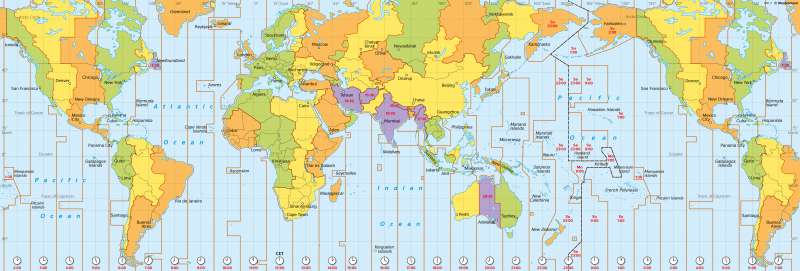The World - Time zones
Global communication
978-3-14-100890-6 | Page 44 | Ill. 2

Overview
Today, most countries adhere to the world time system, although the time zone boundaries are often based on political borders in detail. Only a few oceanic islands and a few countries such as Iran, Afghanistan, India, Nepal, and Myanmar deviate from the world time system by 30 or 45 minutes.
Historical emergence of time zones
From the middle of the 19th century onwards, there was a rapid expansion of railway and telegraph networks worldwide, which led to a strong internationalisation of financial and commodity flows within a few years. The age of large factories and mass production as well as the first large stock exchanges began, and at the same time many corporations and joint-stock companies were founded in the industrialised nations.
The rapid increase in international shipping and railway traffic strengthened the desire for a uniform world time system. In 1884, representatives of 25 countries met in Washington for the International Meridian Conference, where they agreed to divide the Earth into 24 time zones with a geographical longitude of 15 degrees. The conference declared the Greenwich meridian to be the prime meridian, which at that time was already marked as the prime meridian on many nautical charts. This time zone extends from 7.5 degrees west to 7.5 degrees east of the Greenwich meridian. The 180th degree of longitude was set as the International Date Line. In order not to separate national territories arbitrarily, the date line deviates from the 180th degree of longitude in several places, for example in the area of the Aleutian Islands to the west and in the South Seas to the east (Kiribati, Fiji, Tonga, Samoa, New Zealand, see map 160.1).
In the former Soviet Union, the so-called Decree Time was introduced in 1930, by which the clocks in all time zones were advanced by one hour in order to make better use of daylight, similar to daylight saving time. In the 1980s, Decree Time was already abolished in many regions, and from 1991 even in the entire territory of the former USSR, although Russia reintroduced it immediately afterwards. In return, the country abandoned daylight saving time.
Daylight saving time
Only relatively few countries have daylight saving time (summer time), but in Europe it has become the standard. Its start and end are regulated throughout the EU, usually beginning on the last Sunday in March and ending on the last Sunday in October.
The European Union is currently pursuing a plan to abolish daylight saving time.




